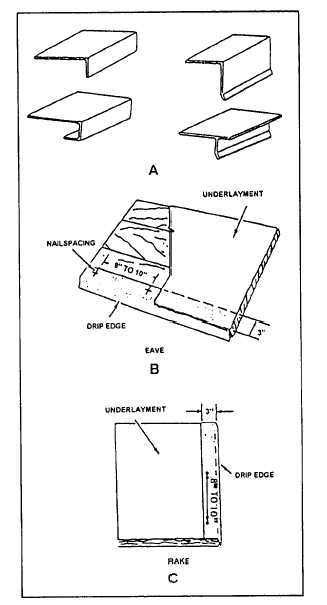shredded wood fibers are considered felts. They are
among the least expensive of roofing felts and are
widely used not only as roofing, but also as water and
vapor retarders. Fifteen-pound felt is used under wood
siding and exterior plaster to protect sheathing or wood
studs. It is generally used in roofing for layers or plies
in gravel-surfaced assemblies and is available
perforated. Perforated felts used in built-up roofs allow
entrapped moisture to escape during application.
Thirty-pound felt requires fewer layers in a built-up
roof. It is usually used as underlayment for heavier cap
sheets or tile on steeper roofs.
GLASS-FIBER FELTS.— Sheets of glass fiber,
when coated with asphalt, retain a high degree of
porosity, assuring a maximum escape of entrapped
moisture or vapor during application and maximum
bond between felts. Melted asphalt is applied so that the
finished built-up roof becomes a monolithic slab
reinforced with properly placed layers of glass fibers.
The glass fibers, which are inorganic and do not curl,
help create a solid mass of reinforced waterproof
rooting material.
TARRED FELTS.— Coal-tar pitch saturated
organic felts are available for use with bitumens of the
same composition. Since coal-tar and asphalt are not
compatible, the components in any construction must be
limited to one bitumen or the other unless approved by
the felt manufacturer.
Flashing
The roof edges along the eaves and rake should have
a metal drip edge, or flashing. Flashing is specially
constructed pieces of sheet metal or other materials used
to protect the building from water seepage. Flashing
must be made watertight and be water shedding.
Flashing materials used on roofs may be
asphalt-saturated felt, metal, or plastic. Felt flashing is
generally used at the ridges, hips, and valleys. However,
metal flashing, made of aluminum, galvanized steel, or
copper, is considered superior to felt. Metal used for
flashing must be corrosion resistant. It should be
galvanized steel (at least 26 gauge), 0.019-inch-thick
aluminum, or 16-ounce copper.
Flashing is available in various shapes (fig. 3-16,
view A), formed from 26-gauge galvanized steel. It
should extend back approximately 3 inches from the
roof edge and bend downward over the edge. This
causes the water to drip free of underlying cornice
Figure 3-16.-Drip edges A. Basic shapes B. At the eave; C. At
the rake.
construction. At the eaves, the underpayment should be
laid over the drip edge (view B). At the rake (view C),
place the underpayment under the drip edge. Galvanized
nails, spaced 8 to 10 inches apart, are recommended for
fastening the drip edge to the sheathing.
The shape and construction of different types of
roofs can create different types of water leakage
problems. Water leakage can be prevented by placing
flashing materials in and around the vulnerable areas of
the roof. These areas include the point of intersection
between roof and soil stack or ventilator, the valley of a
roof, around chimneys, and at the point where a wall
intersects a roof.
3-15

